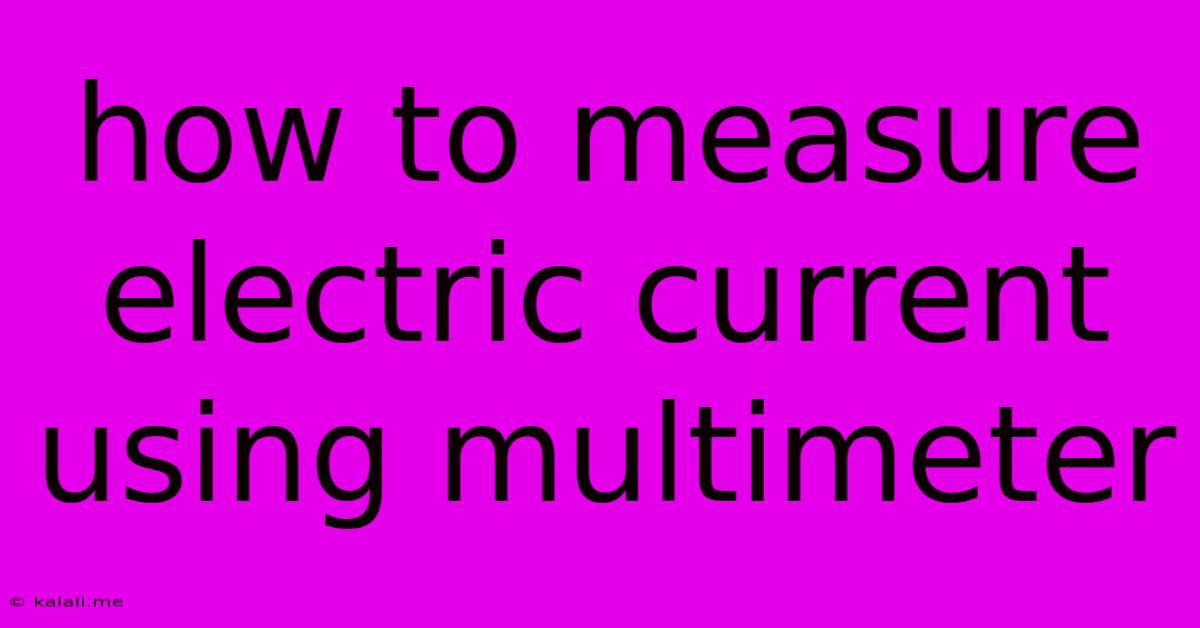How To Measure Electric Current Using Multimeter
Kalali
Jun 01, 2025 · 3 min read

Table of Contents
How to Measure Electric Current Using a Multimeter: A Comprehensive Guide
Measuring electric current accurately is crucial for various electrical and electronic applications, from troubleshooting circuits to ensuring the safety of your devices. A multimeter is the essential tool for this task, allowing you to measure current in different circuits and components. This guide will walk you through the process, covering different types of current and safety precautions.
Understanding Electric Current and Multimeters
Electric current, measured in amperes (amps or A), represents the flow of electric charge. There are two main types: direct current (DC), which flows in one direction, and alternating current (AC), which changes direction periodically. Your multimeter must be able to measure the type of current you're working with. Most multimeters can handle both, but you'll need to select the appropriate setting.
Before you begin, ensure you have the right multimeter for your needs. A basic multimeter is sufficient for many household tasks, while more advanced models offer increased precision and additional features. Familiarize yourself with your multimeter's manual; it will provide detailed instructions and specifications.
Safety First: Crucial Precautions Before Measuring Current
- Always disconnect the power source: Before connecting your multimeter to any circuit, ensure the power is completely off. This is paramount to prevent electric shock.
- Identify the correct current range: Select a current range on your multimeter that is higher than the expected current. Starting with a higher range and gradually decreasing it is a safe practice.
- Use the appropriate leads: Use the multimeter leads specifically designed for current measurement. These are usually thicker than the leads used for voltage measurement.
- Avoid overloading the multimeter: Exceeding the maximum current rating of your multimeter can damage it permanently.
- Proper grounding: If working with higher voltages, ensure you are properly grounded to minimize the risk of electric shock.
Step-by-Step Guide to Measuring Current
Here's how to measure DC and AC current using a multimeter:
1. Selecting the Right Setting:
- Identify the type of current: Determine whether you're measuring DC or AC current.
- Select the appropriate function: Turn the dial on your multimeter to the "A" (amps) setting. Look for symbols indicating DC (–) or AC (~).
- Choose the correct range: Begin with a higher range (e.g., 10A) and adjust downwards as needed. Improper range selection can damage your multimeter or provide inaccurate readings.
2. Connecting the Multimeter:
- Series connection: Unlike voltage measurement which involves parallel connection, current measurement requires a series connection. You need to break the circuit and insert the multimeter into the path of the current flow.
- Positive and Negative Leads: Connect the multimeter's positive (+) lead to the positive side of the circuit and the negative (–) lead to the negative side. Ensure the connections are secure. Incorrect polarity can damage the meter.
3. Taking the Reading:
- Turn on the power: After making all the connections, carefully turn the power back on.
- Observe the display: The multimeter's display will show the current flowing through the circuit.
- Adjust the range if necessary: If the reading is too low (mostly zeros), try increasing the range. If it's off-scale, switch to a higher range immediately.
4. Disconnecting the Multimeter:
- Turn off the power: Switch off the power source before disconnecting the multimeter.
- Remove the leads: Carefully disconnect the multimeter leads from the circuit.
Measuring Small Currents (mA):
Many multimeters also have settings for measuring current in milliamps (mA). The process is the same, but you'll need to select the appropriate mA range on your multimeter. Remember to always start with a higher range and work your way down.
Troubleshooting Common Problems:
- Inaccurate readings: Double-check your connections, the selected range, and the type of current being measured.
- No reading: Verify the power is on, the connections are secure, and the multimeter is set to the correct function and range.
By following these steps and prioritizing safety, you can confidently and accurately measure electric current using your multimeter. Remember to consult your multimeter's manual for specific instructions and safety guidelines.
Latest Posts
Latest Posts
-
Mtg Whenever This Creature Gets A 1 1 Counter
Jun 02, 2025
-
How To Connect Wire Fallout 4
Jun 02, 2025
-
Red Hunting Hat Catcher In The Rye
Jun 02, 2025
-
Can You Use Treated Lumber Indoors
Jun 02, 2025
-
What Film Is This Picture From
Jun 02, 2025
Related Post
Thank you for visiting our website which covers about How To Measure Electric Current Using Multimeter . We hope the information provided has been useful to you. Feel free to contact us if you have any questions or need further assistance. See you next time and don't miss to bookmark.